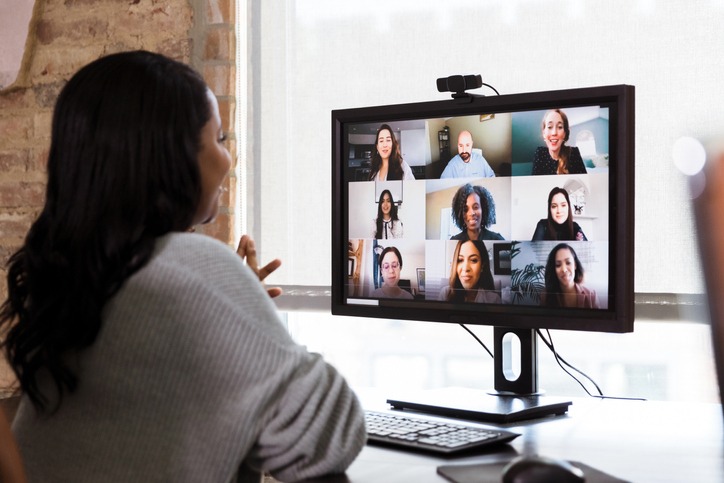5 questions with Kristin Graham
A top company culture expert shares why employers need to check in before employees check out.

Would you give up $30,000, or more, to keep working remotely?
A lot of working professionals would. More than six in 10 people at large U.S. companies – 64% – would prefer to work permanently from home, even if they’d have to forfeit a $30,000-a-year raise, according to a 2021 survey of 3,000 employees conducted by Blind, a platform for anonymous career posts.
Furthermore, 39% of U.S. adults would consider quitting their jobs if their employers didn’t offer flexible work arrangements, according to a May poll of 1,000 people by Morning Consult for Bloomberg News. For Gen Z and millennials, the figure jumps to 49%.
[FREE DOWNLOAD: Communicate the Change You Want to See in the World]
With these trends as context, we talked with Kristin Graham, employee engagement and culture consultant at Ragan Consulting Group.

Kristin Graham
Q: Let’s discuss the importance of corporate culture. Why does it matter?
Graham: It matters more than ever after the world has gone through a productivity experiment in the last 18 months. Innovation blew the dust off of corporate culture, and employees are emboldened to want more than before.
At the baseline level, culture is what companies will hire or fire over. It’s where the line is defined. On a broader level, it encompasses three things:
- What employees are told to expect.
- What employees actually experience.
- What discretionary effort employees are willing to give.
Q: Given people’s changing attitudes toward work, are we seeing a breakdown, or a reinvention, of corporate culture?
Graham: Yes.
Let’s remember: Corporate culture reflects the promises that a company makes and keeps (or doesn’t keep) in relation to the day-to-day employee experience.
Culture is real and visceral, not aspirational.
In some cases, the disconnect has led to a breakdown where trust has been irretrievably broken. Before, employees might have decided to “quit and stay” (that is, put in very little effort), but now they are shopping for new places that are a better fit for their time and talent. Employees are apt to provide companies a little more grace – and choose to evolve with the organization – if they trust that their leaders are willing to listen, acknowledge, and adapt.
Q: Another stat for you: Only four in 10 employees say the mission of their company makes them feel their job is important, according to Gallup. What can HR and communications professionals do to ensure employees are fully engaged with their organization and have a sense of pride?
Graham: Employees are taking a close look at what a company says and what it does. There are several areas where it pays to pay attention to how a culture is being experienced:
- Behavior: The bad behaviors that company leaders tolerate, and the good behaviors they demonstrate.
- Transparency and cadence of information: The less leaders share, the more rumors and speculation will spread.
- Authenticity: Real action and effort behind the words.
- Opportunity for feedback and learning: Not just a comment box in the lobby or a generic email alias.
As the stats are showing, HR and comms pros have a unique opportunity to shape and elevate culture conversations and actions. It’s time to crowdsource your own culture.
Mission, vision, purpose and values are just words on a poster unless they are brought to life through storytelling. Solicit photos, videos, examples and quotes from your teams on what these things look like in everyday ways. When employees contribute to the conversation, they personify the work with their own efforts – no extra email required.
Q: Workers have become used to virtual town halls and virtual, well, everything. What can comms/HR pros do to rebuild in-person, positive corporate cultures?
Graham: First, don’t be generic. Not everyone wants to get cupcakes in the lobby at 3 p.m.
Curate a menu of culture connections, and let your people choose how, when, how long, and how often they want to engage with company information, events and learnings. This is a change management effort, not a communication plan. Success is measured in the option to participate, not in the attendance report or view rates.
Q: You consult with a lot of companies. What are business leaders most concerned about now that return-to-office plans are in the works? What is your advice?
Graham: There is a real (and valid) concern that employees are in wait-and-see mode.
But all the swag and town halls can’t bridge a disconnect from leadership and a shared purpose. Start immediately with conversation forums.
I’m seeing some companies do “pop up” listening events, having dedicated channels for input beyond annual HR surveys, and even taking to the halls and walls with creative collaboration like creating a Post-it note station for conversation or responses to a posed question. Employees have plenty to say, but they won’t be offering ideas and insights into a vacuum.
Keep pushing leaders to be visible and vulnerable. Have them answer the same questions about burnout, productivity, priorities and areas where change is still needed.
Lastly, a shout-out to the comms people reading this: Remember that you, too, are an employee first and foremost. Take care to take care, and do fewer things better. It’s going to take time to build up the energy again, so think of a chef’s menu – not a buffet – when it comes to culture offerings in the next few months.
Kristin Graham is an affiliate consultant at Chicago-based Ragan Consulting Group. RCG specializes in corporate communications training, consulting and strategic counsel. Schedule a call with Kristin Hart to learn how we can help you improve your culture and engagement strategy. Follow RCG on LinkedIn here.






